Review: Intern
Publisher: Avalon Hill
Year: 1979
Tagline: Now YOU are the physician!
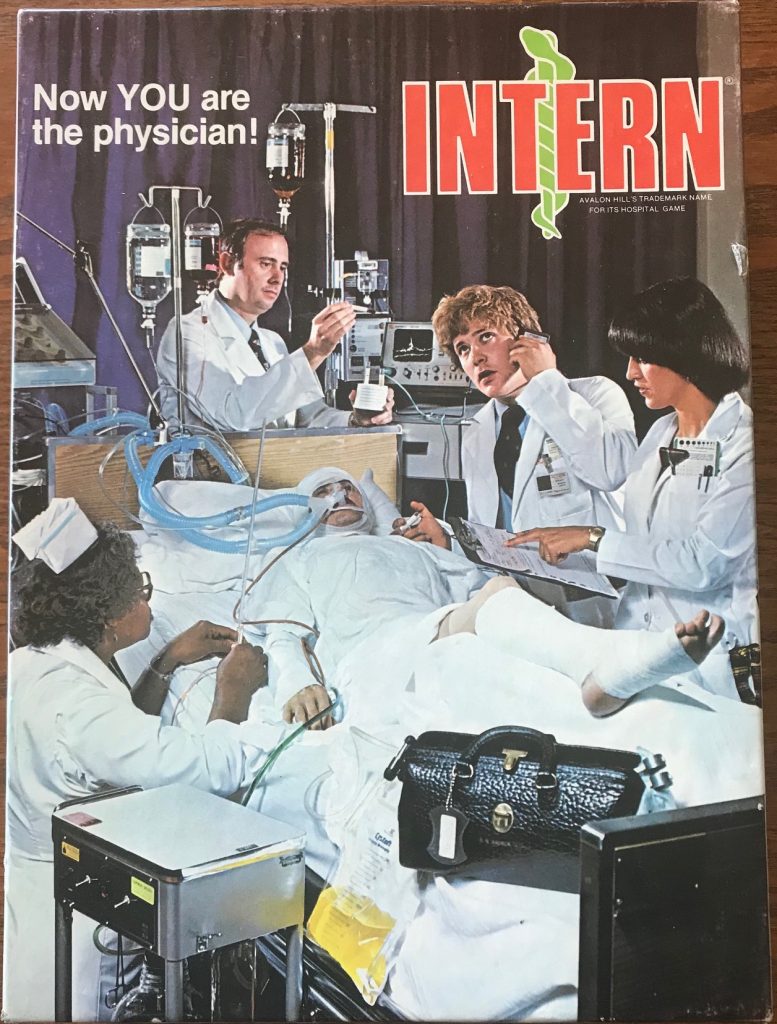
how we met
I met Intern through my witchy ways. A few weeks ago I had never heard of the game before. But about once a month I do a quick board game search on sale sites. I’m not sure why I do this. I have never bought anything, and they usually want way too much. But I saw Intern for the first time on one of these sites. I added it to my wishlist based on the cover and premise.
Fast forward a few hours. Less than a day. Bill and I are walking through a thrift shop we rarely visit because we have rarely found anything there. And there is Intern. For me. My very own copy of Intern, as though I had willed it. It was basically an episode of Black Mirror (one of the less horrifying ones).
how it plays
The object of Intern is to be the first intern to diagnose and treat all the PATIENTs in their department, while scoring points via things like having the most hours in TIME SCRIP accrued and not letting any PATIENTs die. The player with the most points wins!
Intern is a roll and move game where you land on spaces that may help you admit, diagnose and treat your four PATIENTs. A PATIENT must be admitted into one of the three beds in your ward by landing on the PATIENT number in your ward and paying TIME SCRIP equal to the number of the PATIENT to the bank (ie if you land on 2 in your ward you may pay 2 TIME SCRIP to admit PATIENT 2 from ER to your ward into any available bed).
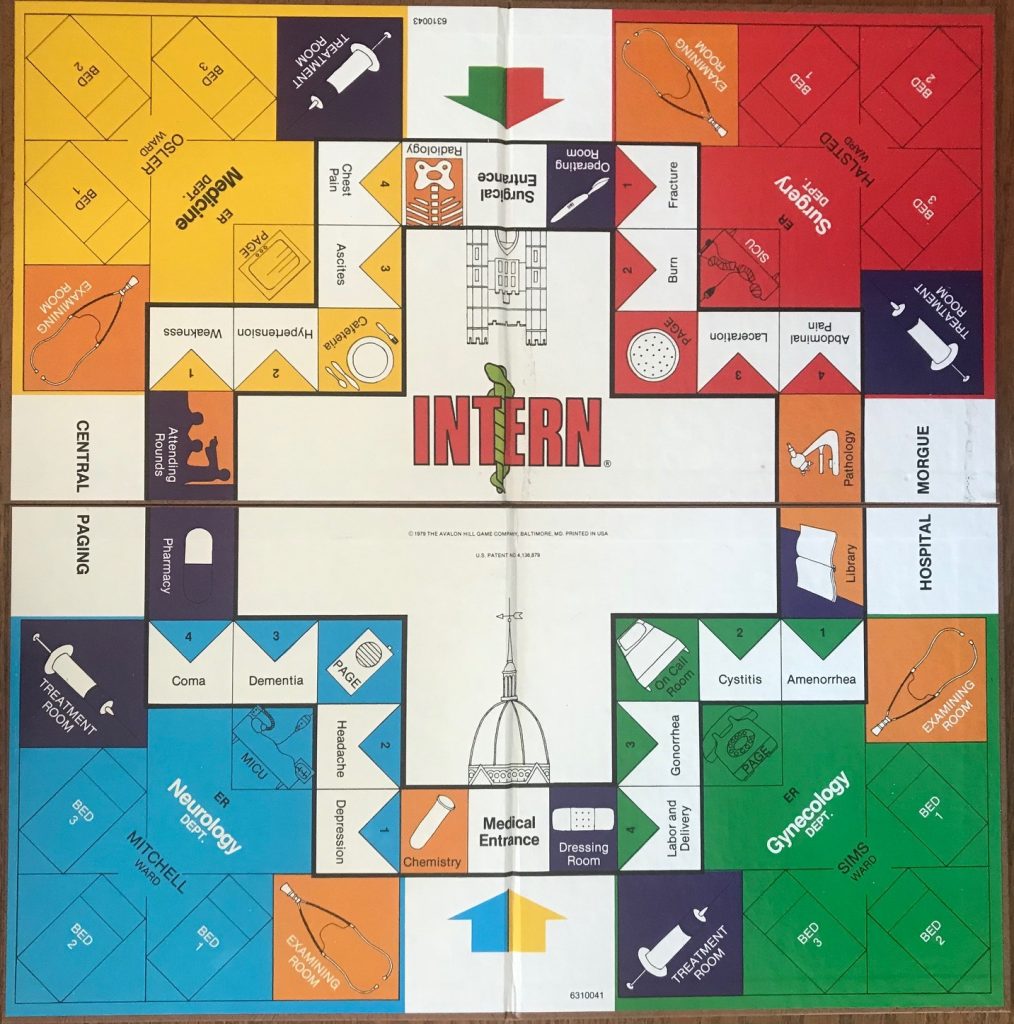
Once a PATIENT is admitted to one of your beds, you match your Diagnosis or Dx CARD to them in order to diagnose them. You collect Dx CARDs whenever you land on an orange space on the board such as Chemistry or Radiology and pay 1 TIME SCRIP.
There are generally two Dx CARDs per PATIENT. One of them has a single arrow at the top and indicates the PATIENT should stay and be treated in your ward. The second has two arrows at the top, indicating another ward that can best treat the PATIENT. If you get the latter Dx CARD then you TRANSFER that patient to the other ward, freeing a bed in your own ward and essentially making that PATIENT someone else’s problem. Otherwise you wait for the other Dx CARD and treat the PATIENT yourself.
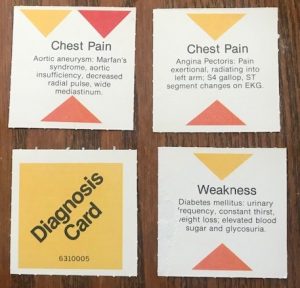
Similar to Dx CARDs, the game has Treatment or Rx CARDs. These cards are obtained by landing on purple spaces on the board like Operating Room or Pharmacy and paying 1 TIME SCRIP. A PATIENT can’t be treated until they have been diagnosed, and they can’t be diagnosed until they have been admitted, and they can’t be admitted until you land on the right space and pay up. Once you are able to accomplish admission, diagnosis and treatment then the PATIENT is considered discharged. Set them aside for later scoring.
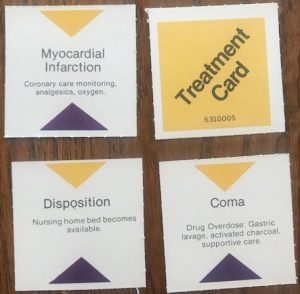
If a player lands on a PATIENT space within another intern’s ward, they must pay that intern out of their TIME SCRIP bank, which is called a CONSULTATION. You know, like they own the property and have a hotel on it. The amount paid depends upon whether the PATIENT number you landed on is admitted, diagnosed, not admitted, discharged, etc.
If you roll doubles you may roll again, but watch out. Rolling doubles three times in a row lands you in ICU! (It’s jail, guys)
And if you roll snake eyes at any time, you have a dead PATIENT on your hands!
Finally there are spaces on the board that cause you to draw a PAGE card. These cards may reward you with TIME SCRIPs, cause you to pay in, cause PATIENTs to move around, allow you to get out of ICU free or even stick you with the WILD TURKEY patient, an undiagnosable hot potato.
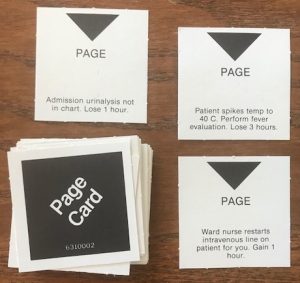
When you pass the entrance of your own ward, collect 6 hours of TIME SCRIP. (It’s go, guys)
There are a few other spaces that give you options of what to do when landing on them, but they are a combination of the spaces already noted here.
Once a player has no PATIENTs left in their ward or ER the game ends and points get awarded according to a long list of 11 things. The intern with the most points wins Intern!
how it went
Since I will probably not be very kind to Intern, I will start by saying that the rulebook strongly recommends 4 players, but we played 2 player and used the adjusted rules for it. Normally I would pull John and Keri into the fold for a game recommended at 4 players, but this one just wasn’t worth playing through again.
So Intern is a hospital-themed Monopoly, in case that was not clear. One thing that sometimes bugs me with vintage games is the abandonment of theme. That is not a problem with Intern, and in fact results in hugely over-complicating what is otherwise a simple, reskinned type of gameplay.
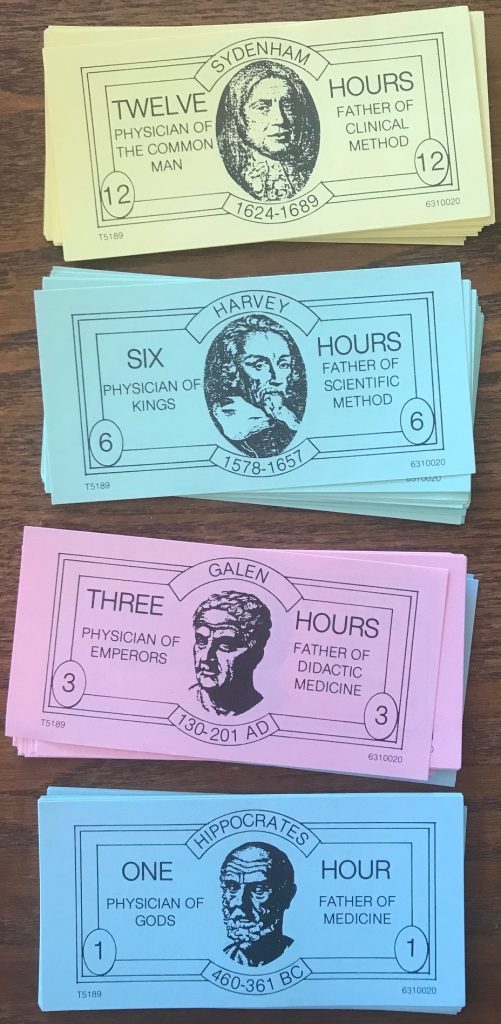
There are a full six pages of rulebook that you must read in order to play the game properly and learn about all the little nuances. The rules themselves are not complex, but six full pages of walls of text is too much. These could have used some reorganization and an editor.
Another example of overly complicating the game is having us run through 11 items in a list to add up our score. 11!
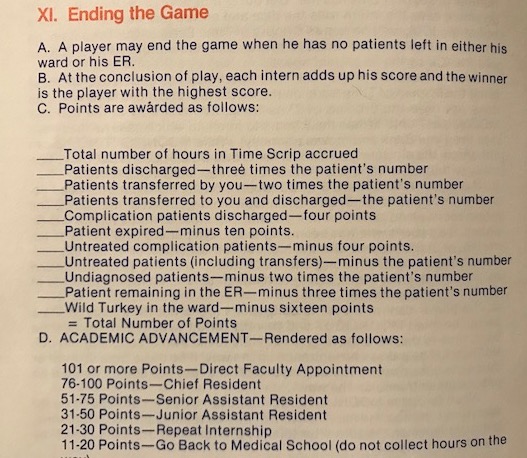
The BGG comments do give fair warning: if you work in a medical field then you may enjoy the game but otherwise you are not likely to. Fair enough.
I actually admire the decision to be loyal to the theme. I myself have made a niche card game and given deference to theme over gameplay. But I also stuck a big, fat time limit on it.
Intern falls into the classic pain point of requiring you to land on certain spaces by exact count. You can probably roll well enough to get a few PATIENTs into your ward, but in our play we both were sitting on one or two PATIENTs waiting admission for a long time. It’s a grind. You miss the space you need and settle in for another spin around the entire fucking hospital. I was actually kicking ass at the game until I fell into this endless merry-go-round and never did end up getting my last PATIENT admitted.
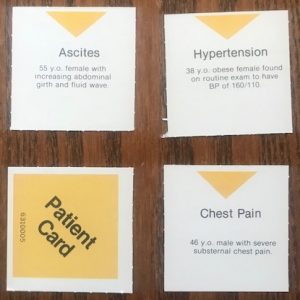
Bill won our game of Intern by a long shot. I ended up with the dumb WILD TURKEY patient and no means to transfer them. And that was our Intern play. Pagers were paged. Patients were diagnosed, treated and discharged. Some lives were lost. And hours were spent, both in game and out.
But would I get up and do it all again tomorrow? Nope.
play or pass
Pass. Reading the rulebook will be just the beginning of your long, arduous journey. I am not the target market for Intern, but the gameplay was long and slow and it hurts here when I play it.
* points to heart *
* points to head *
* points to watch *